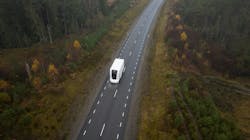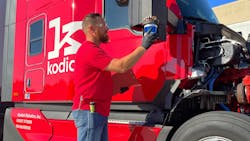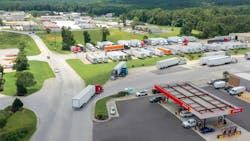Road to humanless trucking hits a California-sized political pothole
More than 85,000 people were killed on U.S. highways in 2021 and 2022—the largest two-year motor vehicle traffic fatality rate on record. Makers of autonomous truck technology believe they can reduce those numbers by taking humans out of the equation. Many states, such as Texas, Arkansas, Georgia, and Ohio, have embraced AV testing. Trucks with human safety operators on board are hauling freight all over the Sun Belt—but actual coast-to-coast autonomous freight operations won’t be possible this decade if California legislators have their way.
Although at least 40 states allow autonomous truck testing, AB 316, a union-backed bill to ban humanless trucks on California's roads, passed the state Assembly in June and has been working its way through the state Senate. While most AV trucking companies have said that humanless long-haul freight movement could be a reality by mid-decade, politicians in California—a state known for its technology and transportation innovation—want to push off that possibility until 2030.
Governor Gavin Newsom's administration recently indicated it doesn't support the legislation. In an August letter to AB 316 author Assemblymember Cecilia Aguiar-Curry, the Governor's Office of Business and Economic Development—known as GO-Biz—noted that the legislation could impact California's economic competitiveness and hamper supply chain infrastructure investments.
"Our state is on the cusp of a new era and cannot risk stifling innovation at this critical juncture," wrote Dee Dee Myers, GO-Biz director and senior advisor to the governor. "In addition, California has the strongest workplace standards and worker protections in the nation. We remain committed to supporting this evolving technology, which can increase public safety and economic competitiveness, while being deliberate about incentivizing career pathways including training the necessary workforce."
The decarbonization argument
Brett Suma, founder and chief executive of freight startup Loadsmith, told FleetOwner he plans to implement “driver-out” trucking by the second half of 2025 to create “the world’s first fully autonomous trucking company.” He said that AV technology supplementing long-haul would benefit an industry facing significant driver shortages by creating better local driving jobs while robotic trucks handle long-haul routes.
But some of the busiest freight lanes originate or end in California, which, along with a balking attitude toward AV technology, is pushing the trucking industry to ditch diesel-powered equipment and replace these tractors with alternative fuels and battery-electric trucks. Suma thinks focusing on the decarbonization benefits of AV trucking could shift the tide out West: Autonomous trucks are more efficient than human truck drivers, on average, using 10% less fuel.
See also: How Loadsmith plans to use autonomous trucks to boost driver jobs and cut emissions
“California will get there eventually,” Suma said. “I'm very confident in California. I think their regulatory hurdle will be quickly overcome as soon as somebody can adequately articulate how they can decarbonize the Ontario-to-Stockton lane, the densest lane in all of the U.S. It's the largest lane from a greenhouse emissions perspective in the U.S. that can only be decarbonized through autonomous because the economics of it won't work if you don't.”
Around the same time AB 316 was introduced in the California Assembly, Loadsmith announced it ordered 800 Kodiak Robotics autonomous trucks. The AVs would serve as the foundation of its capacity-as-a-service model that would autonomously move goods along the busiest freight lanes in the nation while teaming up with smaller fleets and owner-operators for the first and final miles.
The safety argument for autonomous trucks
While Suma and Loadsmith are focused on self-driving trucks’ potential sustainability and job creation, AV companies and the Autonomous Vehicle Industry Association are focused on safety.
The U.S. Department of Transportation requires all autonomous vehicle operators to report any on-road incident, which Jeff Farrah, executive director of AVIA, said is the most transparency required of any vehicle on U.S. roads.
“There has never been a fatality involving an autonomous truck,” he notes. “Precisely one person has been injured in a crash involving an autonomous truck—and that crash was caused by a human driver who cut off the autonomous truck. This is a stellar record after millions of miles driven in testing and pilots with industry partners, including IKEA, FedEx, J.B. Hunt, and Tyson Foods. These claims also obscure the heavy toll we pay each year in fatalities caused by human-driven trucks—some 5,700 deaths nationwide in 2021.”
See also: Einride is digitizing freight to grow electric, autonomous, sustainable solutions
Michelle Avary, VP of product strategy and government affairs at Einride, which makes autonomous and electric transports, told FleetOwner that AV performance standards are higher than human expectations.
“Everybody cares about safety,” Avary said. “How do you define what is a safe autonomous vehicle? You can do that based on performance standards and expected performance behavior and then measure against that expected baseline performance.”
She said one of the benefits of autonomous vehicles is that their software is constantly updated as engineers learn ways to improve the technology. “This is not a static technology. It isn’t a one-way technology.”
Avary used the example of human drivers, who, through experience on the road, are typically much better drivers than when they first got their driver’s license. “We also expect that progression as we move through these technologies,” she explained. “That’s really important as we know we have to focus first and foremost on safety—and these things are going to improve over time. Then we can share these things, and we can also share them legislatively. Once you base it off performance-based regulations—as opposed to saying how you’re going to do it—then you really get to a win-win situation.”
Working with regulators
Joanna Buttler, head of Daimler Truck’s global autonomous technology group, said that Daimler, which has a majority stake in AV pioneer Torc Robotics, worked closely with California regulators long before AB 316 was first proposed. She said the safety benefits of AV technology will win out in the end. “Regarding regulatory initiatives, I truly believe that decisions will be made with reason, and we will have multiple voices in the room explaining why this is a good thing for our industry and society—and also explaining potentially the consequences of blocking a certain area or region from it.”
Buttler told FleetOwner that the most significant initiative the AV world can do is build trust by being transparent. “The minimum requirement for all of us is doing this safely,” she said. “No one wins in this market if any of the other providers have an incident, so doing this together safely and speaking with one voice—but also being responsible in development—is very important.”
See also: Torc zooms in on the AV perception challenge
The Autonomous Vehicle Industry Association, which is made up of several AV technology providers and OEMs, is on a mission to be the voice of reason for regulators. Noting that 4,407 people died on California roads in 2022, AVIA recently urged California Gov. Gavin Newsom to oppose AB 316 and instead help his state lead the way in responsibly regulating and embracing autonomous trucks as a way to ease supply chain challenges, address safety, and create jobs.
Farrah cited a U.S. Department of Transportation-funded study that found that self-driving trucks could create $111 billion in aggregate investment spending across the U.S. and add more than 26,000 jobs annually.
“AB 316 is not just premature and unnecessary, but dangerous,” Farrah and AVIA general counsel Ariel Wolf wrote to Newsom in August. “The autonomous vehicle industry has offered reasonable compromises that have been rejected at every turn. This reckless action by some in the legislature will cement California’s unacceptable safety status quo—thousands of fatalities each year. AV technology offers a safer tomorrow for Californians, but some in the legislature are intent on killing that California-developed innovation today."
“California has a long and proud tradition as a leader in transportation innovation—from electric cars to the first ride-hail apps,” they continued. “Autonomous vehicles across all vehicle modes represent the future of transportation.”
AVIA notes that it isn’t against AV regulations—it just wants those regulations to come from transportation experts, such as the California Highway Patrol and Department of Motor Vehicles, not lawmakers “playing politics with public safety.”
The trade organization notes that California regulators are still working with AV stakeholders to develop state regulations for autonomous trucking operations. “Until a regulatory regime is established, autonomous trucks remain unable to operate on California roads,” the pair noted in the letter to Newsom, adding that “AB 316 would insert the legislature into safety regulators’ role and thwart the thoughtful process of your administration.”
Since that letter was sent to the Golden State's executive branch, its DMV leader noted that roadway safety is the agency's top concern. "DMV will continue to take action to provide for the safe and responsible development and implementation of autonomous vehicle technology, while also working with other government agencies, the legislature, industry, and other traffic partners," Steve Gordon, DMV director, wrote in an Aug. 16 letter to the State Assembly. "DMV opposes AB 316 because it will not increase safety and will, in fact, have a chilling effect on the development of technology in California that is intended to result in increased safety benefits on our roadways."
California AV companies drive east
Mountain View, California-based Kodiak Robotics, an AVIA-member company, bases most of its testing out of Texas and is moving freight across the South with safety operators on board.
“Look, I'm not going to pretend that I love AB 316,” Daniel Goff, head of policy at Kodiak, told FleetOwner. “Obviously, I think it's a huge mistake. It's a little bizarre in our home state to see this kind of reaction. That being said, California is a unique state. It's a unique state in terms of its relationship to the tech industry. It's a unique state in terms of the power of transportation and labor. And fundamentally, there's a reason why we have built our business in Texas.”
Goff noted that while California has limited AV trucking within its borders, Texas has been proactive in looking at how to integrate self-driving truck technology into supply chains, including passing legislation and appropriating money for studies into how it impacts the economy.
“I think we’re in a position of wanting to be regulated,” Goff said. “We understand that many people haven’t gotten used to this technology yet. But 100% of the people who have had the opportunity to see a Kodiak truck and kick the tires—all of them—get it. They get that this is going to make the roads safer. They get the potential of the technology.
“We can’t invite 350 million Americans to come to our warehouse in Texas—as much fun as that would be—so I think that the more kind of regulations get in and create rules that give us both regulatory certainty and also sort of reassure the public, the better off we are.”
Goff noted that Kodiak has been working with law enforcement and the Commercial Vehicle Safety Alliance to develop roadside inspection standards for AV trucks. It launched a pilot with Texas officials that uses Drivewyze technology to facilitate interactions between law enforcement and humanless trucks.
Better efficiency and utilization
Suma of Loadsmith said the potential benefits for society and the trucking industry are just too good to pass up, and he believes that California will eventually come around.
An AV truck can operate about 2.5 times as much as a conventional truck, which requires drivers to adhere to hours-of-service rules. Theoretically, robotic trucks could operate almost 24/7. While they cost more to buy than traditional equipment, long-haul drivers account for about 40% of fleet costs.
Suma said that autonomous battery-electric or hydrogen-powered trucks could also fit more easily in AV operations, such as the network his team at Loadsmith is designing. Using his Ontario-to-Stockton, California, 400-mile freight lane example, he said you could build out charging or alternative fueling infrastructure based on the predictability of humanless freight transport.
“Then you just have to build one truckport in Ontario and one truckport in Stockton for EV charging and hydrogen fueling—instead of trying to solve the problem everywhere,” he explained. “That's all you have to do.
“If California wants to be a leader in decarbonization, the path forward for them is there, but it has to be autonomous to do it. They have to get on board, and the path to get them there is through decarbonization efforts.”
About the Author
Josh Fisher
Editor-in-Chief
Editor-in-Chief Josh Fisher has been with FleetOwner since 2017. He covers everything from modern fleet management to operational efficiency, artificial intelligence, autonomous trucking, alternative fuels and powertrains, regulations, and emerging transportation technology. Based in Maryland, he writes the Lane Shift Ahead column about the changing North American transportation landscape.





